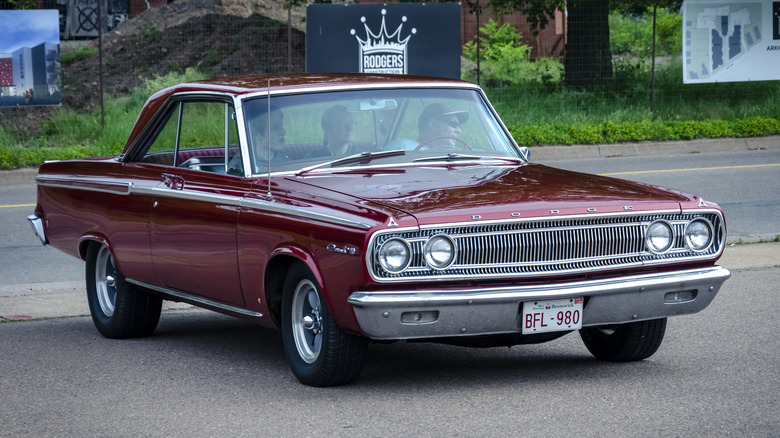
Kenmo/Getty Images
When Chrysler introduced its Slant-Six engine in the early 1960s, it pioneered an ingenious design that tilted the cylinders at a 30-degree angle. This compact packaging allowed the long inline-six to fit in tighter engine bays while lowering the center of gravity for enhanced handling. The Slant-Six’s simple design with a single camshaft, hydraulic lifters, and cast iron construction made it a rugged and reliable power plant.
Displacements ranged from 170 to 225 cubic inches, with the smaller 2.8-liter version producing 115 horsepower and the 3.7-liter making 145 hp. Though modest by today’s standards, the Slant-Six’s torque outputs ranged from 175 to 215 lb-ft, providing perky acceleration along with stellar fuel economy. Meanwhile, the firing order of 1-5-3-6-2-4 gave it a distinctive exhaust note. With basic maintenance, the over-engineered bottom ends could log over 200,000 miles of service.
The Slant-Six engine stood out for its simplicity, making it a favorite among gearheads for its maintenance and repair. Now, classic cars with Slant-Six engines grab attention at car shows, bringing back memories of a laid-back era in history.
The trailblazing 1962 Dodge Dart
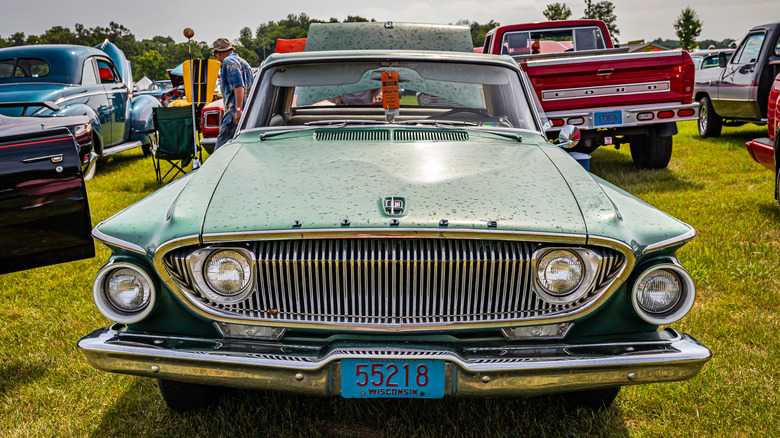
Different_brian/Getty Images
The birth of the 1962 Dodge Dart marked a pivotal shift when Chrysler downsized its larger models in anticipation of changing market demands. Though the rest of the industry didn’t immediately follow suit, the compact Dart struck a chord with its unique styling and thorough engineering.
Under the hood, the Dart’s base power plant was Chrysler’s new leaned-out 170 cubic inch Slant-Six making 101 horsepower and 175 lb-ft of torque. Upgrades included the 225 cubic inch version with 145 hp and 215 lb-ft. For more gusto, the 318 cubic inch LA-series V8 churned out 230 horsepower and 340 lb-ft of twist.
The Dart featured innovations like adjustable suspension components for tuning ride height and camber, as well as a printed circuit instrument cluster wiring harness. Body styles included a two-door coupe, four-door sedan, and station wagon on a 116-inch wheelbase. Braking came from manual Bendix drums at all four corners with bonded linings.
The legendary 1964 Plymouth Barracuda
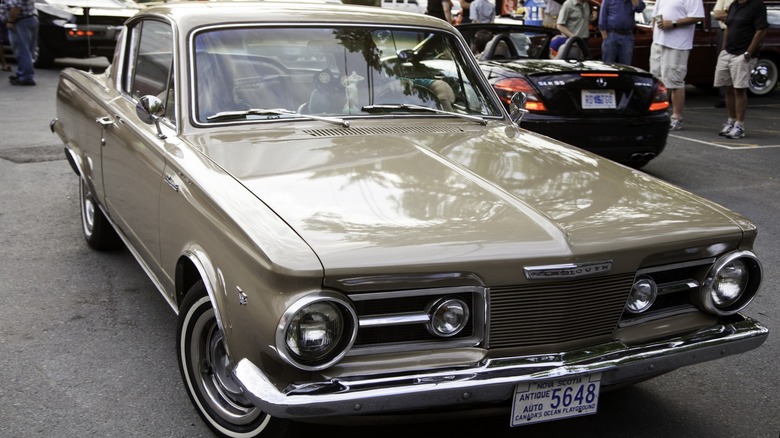
Tomeng/Getty Images
Enter the world of the 1964 Plymouth Barracuda, a car that made a lasting impression with its smooth and innovative style. It was a sort of introduction to the pony car period, showing off an outside design that mixed beauty with a strong and active look.
The 1964 Plymouth Barracuda was a sporty relative of the Plymouth Valiant, featuring a sleek roofline and the iconic Glassback rear window, which was a large wraparound glass panel that extended into the trunk area. It housed the Slant-Six engine tilted at 30 degrees, delivering 145 horsepower at 4,000 rpm and 215 lb-ft of torque at 2,800 rpm. For more power, the Commando option offered a 273 cubic inch V8 engine with 180 horsepower at 4,400 rpm and 280 lb-ft of torque at 2,800 rpm.
The Barracuda had a unitized body construction and featured independent front suspension with torsion bars and a live rear axle with semi-elliptic leaf springs. It was eventually available in fastback and convertible body styles and could be equipped with various options, such as bucket seats, a center console, and a tachometer.
The versatile 1965 Dodge Coronet
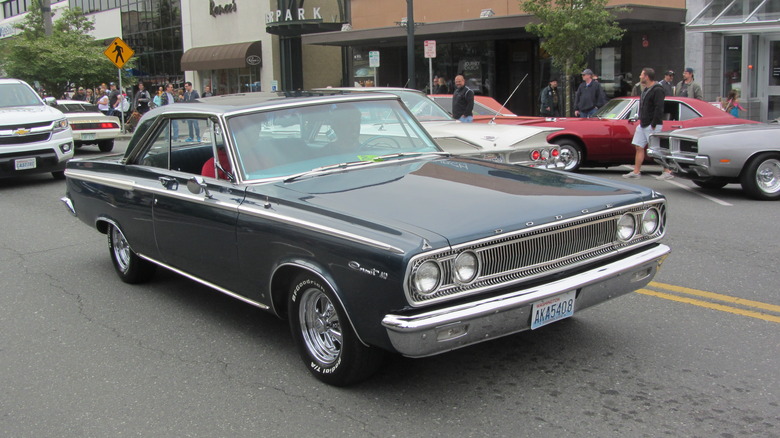
JOHN LLOYD/Wikimedia Commons
For 1965, Dodge offered its Coronet line of mid-sized cars in a wide range of body styles and drivetrain options to suit any buyer’s needs. The base engine was Chrysler’s trusty 225 cubic inch Slant-Six making 145 horsepower and 215 lb-ft of torque. This lean inline-six design provided eager performance along with reasonable fuel economy.
For more vigorous motivation, Dodge’s robust V8 engines could be selected. Options ranged from the 273 cubic inch LA-series V8 up to the thunderous 426 cubic inch Hemi V8. In its most potent form, the 425 horsepower 426 Hemi could rocket the Coronet from zero to 60 mph in under six seconds with its 490 lb-ft of torque on tap.
The Coronet came as a two-door hardtop or convertible, a four-door sedan, and a station wagon configuration riding on wheelbases from 117 to 121 inches. Unibody construction with a torque box structure delivered solid road manners. Up front was independent suspension with torsion bars, while semi-elliptic leaf springs were located on the solid rear axle. In 1965 there were over 200,000 models built, a symbol of reliability and supremacy.
[Featured image by JOHN LLOYD via Wikimedia Commons | Cropped and scaled | CC BY-SA 2.0]
The resilient 1967 Plymouth Belvedere
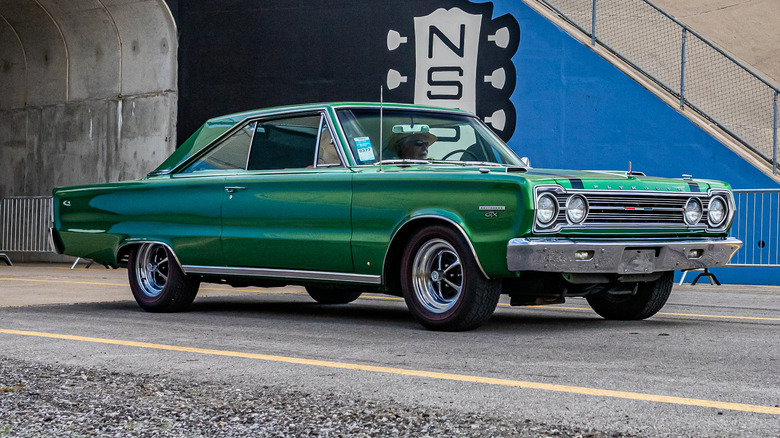
Different_brian/Getty Images
While Chrysler’s lineup offered larger, more opulent nameplates, the 1967 Plymouth Belvedere brought performance to the masses with its potent powertrain options. The base engine was the company’s venerable 225 cubic inch Slant-Six producing 145 horsepower and plenty of torque from its overhead valve design. With a heavy-duty valvetrain and 8.4:1 compression, it could happily rev while delivering thrifty fuel economy.
For those desiring V8 power, Plymouth offered its 273 cubic inch V8 as an enticing option in the Belvedere. With a sturdy cast iron block along with performance-tuned intake and exhaust, it provided an energizing boost in acceleration.
The Belvedere also came well-equipped with contemporary safety features like dual exterior mirrors, a dual-circuit brake system, three-point seatbelts, and an energy-absorbing steering column. Its suspension tuning delivered precise, confidence-inspiring handling befitting its performance pedigree. Surviving 1967 Belvederes remain prized by Mopar enthusiasts for their robust drivetrains and road-holding prowess. The Slant-Six’s ingenious design made it a paragon of power and durability in the compact engine segment.
The timeless 1969 Plymouth Satellite
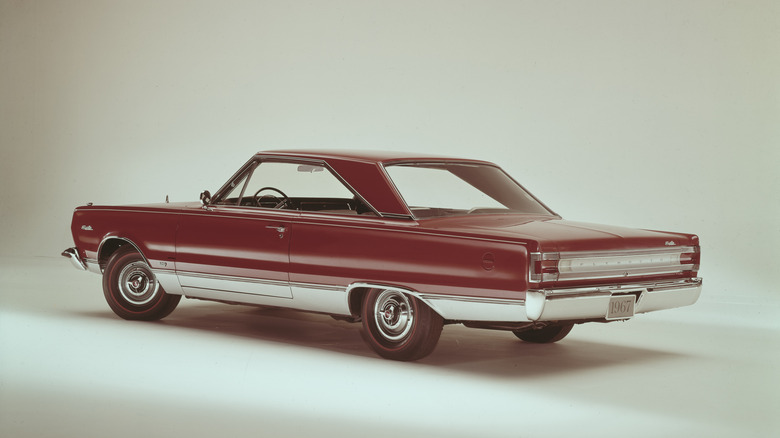
Keystone/Getty Images
The 1969 Plymouth Satellite was a mid-sized car offered in several trim levels. It shared its basic platform with the Plymouth Belvedere but had more upscale trim and styling. For 1969, Plymouth redesigned the Satellite line, including a new two-door hardtop model styled after the Road Runner with its concave rear window treatment. The Sport Satellite package offered both hardtop and convertible versions.
Satellites had a standard 225 cubic inch Slant-Six making 145 horsepower or 318 V8 with 230 horsepower. Optional V8s included the 383 cubic inch, available with either a two- or four-barrel carburetor, and the 440 cubic inch, with either a four-barrel or triple two-barrel carb setup. Transmission choices were a three-speed manual, four-speed manual, or three-speed TorqueFlite automatic, with floor-mounted automatics utilizing a slap stick shifter.
The GTX doubled down on performance with the 375 horsepower 440 cubic inch Super Commando V8 and the 426 Hemi as an optional upgrade. With the Hemi and automatic transmission, the GTX could blast from zero to 60 mph in an exhilarating 6.5 seconds, making it a quick muscle car.
There was a kaleidoscope of 18 vibrant paint colors to choose from, all with creative names like Bahama Yellow, Sassy Grass Green, and In-Violet. Interiors were available in 13 different styles in eight colors, all of which were accompanied by a new cloth and vinyl bucket seat option.
The formidable 1970 Plymouth Valiant
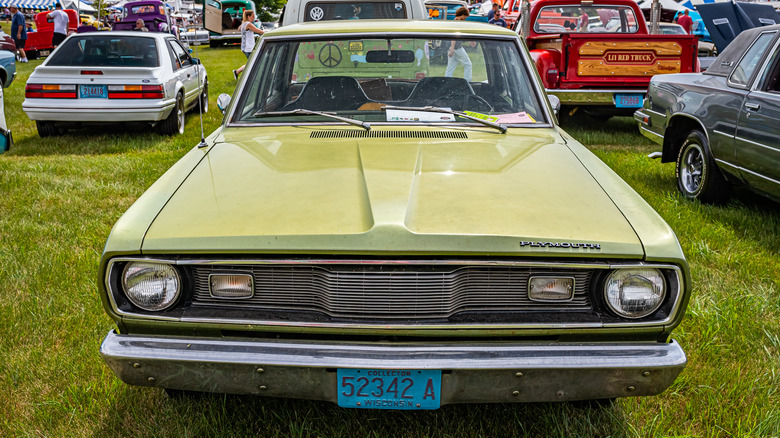
Different_brian/Getty Images
The 1970 Plymouth Valiant was a compact car known for its durability and practicality. Under the hood, it offered two versions of Chrysler’s Slant-Six engine. The base engine was a 198 cubic inch inline-six producing 125 horsepower and 180 lb-ft of torque, while an alternative 225 cubic inch Slant-Six made 145 horsepower and 215 lb-ft of torque. These Slant-Six engines featured overhead valve designs and excellent low-end torque.
Transmission options included a three-speed manual or a TorqueFlite automatic. For improved traction, the Valiant could be optioned with a limited-slip Sure Grip differential. The Valiant’s unitized body design provided extra structural rigidity, and its extended wheelbase of 108 inches provided a spacious cabin for a compact car.
While not designed for high performance, the Valiant earned a reputation for ruggedness and reliability. Its simple design made it easy to maintain and repair. Many components were shared across Chrysler models for years, ensuring the availability of replacement parts and making the Plymouth Valiant a great project car today. The Slant-Six engines, in particular, became known for their longevity. Coupled with rust-resistant unitized construction, this allowed well-maintained Valiants to remain roadworthy for decades after production ended in 1976.
The classic 1970 Dodge Challenger
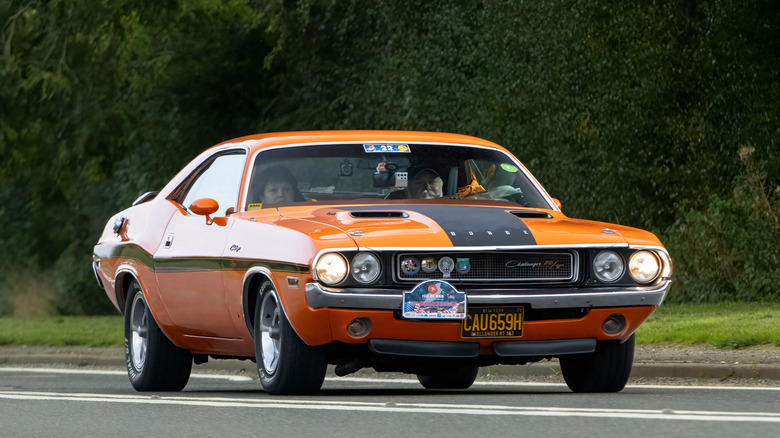
Sue Thatcher/Getty Images
The 1970 Dodge Challenger was a pony car built on Chrysler’s E-body platform, which it shared with the Plymouth Barracuda. It offered a wide range of engine options to suit every performance need. The base engine was Chrysler’s reliable 198 cubic inch Slant-Six making 125 horsepower and known for good fuel economy. For more power, the Challenger could be optioned with a variety of V8s starting with the 318 cubic inch V8 producing 230 horsepower.
Next up was the 340 cubic inch V8, which produced 275 horsepower. The 383 cubic inch V8 pumped out a formidable 330 horsepower. For even more muscle, the 440 cubic inch V8 made 375 horsepower. At the top was the legendary 426 cubic inch Hemi V8 cranking out 425 horsepower and 490 lb-ft of torque for unparalleled straight-line performance.
All Challengers came equipped with a robust chassis and suspension tuned for performance. This included a torsion-bar front suspension, heavy-duty rear suspension built for hard launches, power-assisted disc brakes up front, and drum brakes in the rear. The stout underpinnings allowed the Challenger to put its prodigious power down effectively while still providing decent road manners and handling for its size. Transmission options included three- and four-speed manual gearboxes or Chrysler’s ultra-reliable TorqueFlite three-speed automatic.
While focused on performance, the Challenger also offered typical pony car amenities like optional air conditioning, power steering, and brakes. In addition, upgraded vinyl upholstery allowed the Challenger to serve as a capable grand touring car when not burning rubber.
The enduring 1976 Plymouth Volare
Plymouth continued offering affordable mainstream transportation with the Volare lineup for 1976. The range included two- and four-door sedan models as well as a wagon variant across Base, Custom, and Premier trim grades. Underneath the hood beat a stalwart 225 cubic inch Slant-Six as the entry-level power plant. Though detuned slightly to 100 horsepower, this overhead valve inline-six still delivered admirable fuel economy from its compact, lean-burn design that had been a Chrysler staple since the 1960s.
For those desiring more thrust, the Volare could be optioned with one of two robust V8 engines. The first was the proven 318 cubic inch V8 churning out 150 horsepower and 265 lb-ft of torque through a two-barrel carburetor. At the top was the larger 360 cubic inch displacement making 170 horses and 280 lb-ft of torque, also with two-barrel induction.
Like its contemporaries, the Volare offered a bounty of optional equipment to let buyers customize their rides. The order sheet included items like a manual sunroof, air conditioning, towing package, power amenities, and a choice of wheels ranging from basic hubcaps to Mopar Road Wheels and sporty Rallye options.
Underpinnings consisted of a unitized body shared with Dodge’s Aspen model utilizing double-wishbone front suspension and a live rear axle located by semi-elliptic leaf springs. While not particularly powerful or athletic, the 1976 Volare succeeded by delivering honest, spacious, and economical transportation along with Chrysler’s reputation for long-haul durability.
[Featured image by JOHN LLOYD via Wikimedia Commons | Cropped and scaled | CC BY-SA 2.0]